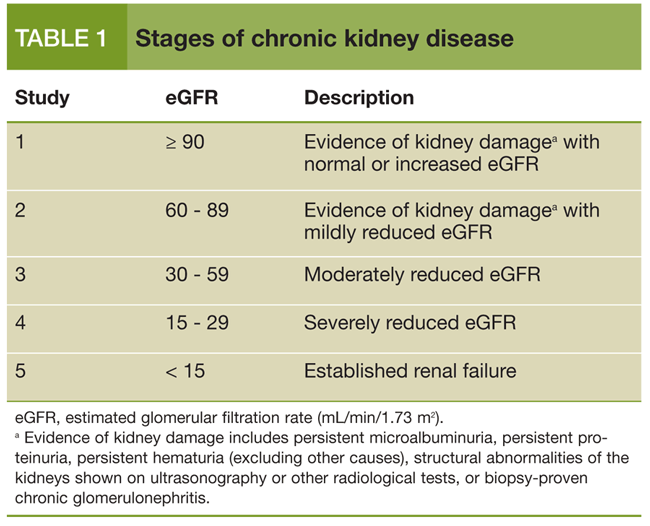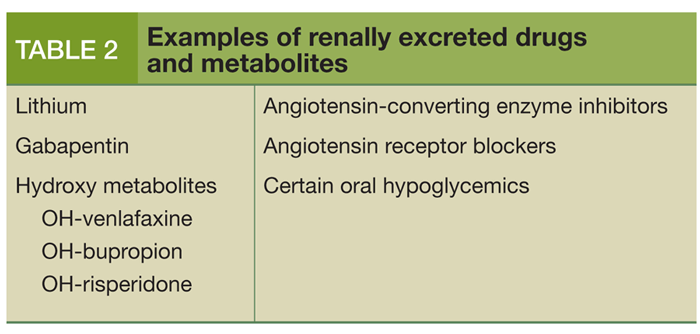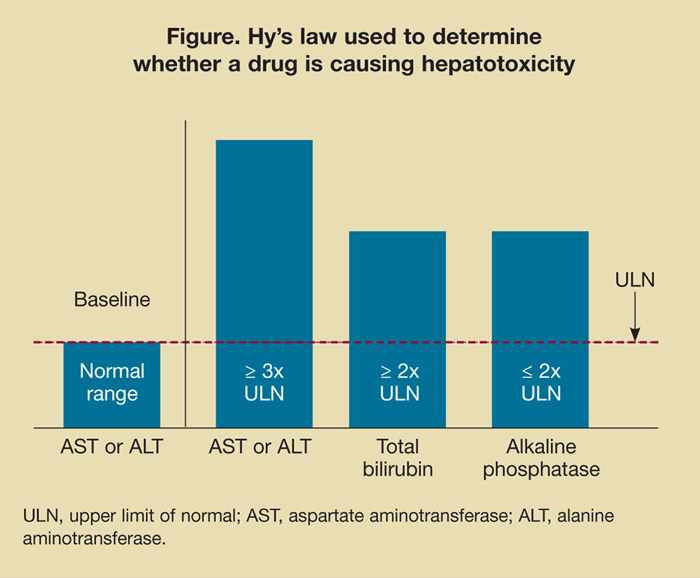Publication
Article
Psychiatric Times
Consultation/Liaison Psychiatry in Geriatrics: Overcoming Challenges and Finding Solutions
Author(s):
This article summarizes 5 cases from consultation services at several teaching hospitals. These challenging cases illustrate several points for the consultation/liaison psychiatrist to consider in caring for elderly hospitalized patients.
TABLE 1 Stages of chronic kidney disease

TABLE 2 Examples of renally excreted drugs and metabolites

Figure. Hy’s law used to determine whether a drug is causing hepatotoxicity

The consultation/liaison service provides an excellent opportunity to showcase the skills and knowledge base of psychiatrists. Clinical issues that arise at the interface of psychiatry, medicine, and surgery can prove challenging and often require a multimodal approach that involves pharmacological and nonpharmacological interventions. This article summarizes 5 cases from consultation services at several teaching hospitals. Each case includes notes on the consultation problem posed, pertinent details of the psychiatry team’s evaluation, and the outcome of the consultation.
The poisoned patient: the case of Mrs Shaw
Mrs Shaw, aged 85 years, was admitted to the hospital in a dehydrated state after several falls at home. The medical team consulted the psychiatry service to request a determination of whether she had the capacity to make her own decision about placement after discharge. Her expressed preference was to return home, but the team and her family felt that assisted living placement was indicated because of fall risk. In this case, the challenge involved a standoff between the two sides.
On first encounter, Mrs Shaw appeared mildly sedated and was irritable when awakened for the interview. She was angry that her doctors were not paying attention to her requests and held the belief that the only reason she was having problems was because she was being “poisoned” by prescription drugs. The nurse caring for Mrs Shaw reported that she had been claiming this since her admission, and she had been resistant to taking the prescribed medications.
Mrs Shaw scored 28/30 on the Mini-Mental State Exam (MMSE). She did not endorse symptoms of depression. She was questioned in detail about her current situation of independent living. Her children were contacted to confirm that except for her recent falls, she was managing well. The team concluded that Mrs Shaw did have the capacity to make her own decision about placement.
Mrs Shaw’s laboratory values were in the normal range, except for a serum creatinine level of 1.7 mg/dL (upper limit of normal, 1.2 mg/dL). Blood urea nitrogen level was 20 mg/dL. An estimate of her glomerular filtration rate (eGFR) was obtained using the Modification of Diet in Renal Disease formula, which requires the user to input the patient’s sex, ethnicity, age, and serum creatinine value.1 The eGFR at 29 mL/min/1.73 m2 indicated severe reduction in renal function (Table 1).
Given this degree of renal insufficiency, could medications be causing Mrs Shaw’s falls, as she claimed? Psychotropic drugs and metabolites that are primarily renally excreted would be most affected by reduced renal function.2Table 2 shows several psychotropics and some commonly used nonpsychotropics in this category. Mrs Shaw’s medications included gabapentin 600 mg 3 times daily for peripheral neuropathy. This drug may cause somnolence and ataxia in older patients, particularly at toxic levels. Gabapentin is cleared exclusively through the kidneys, and for such drugs, the dose should be reduced in proportion to the reduction in eGFR. A normal eGFR is 60 mL/min/1.73 m2 or higher. Because Mrs Shaw’s eGFR was reduced by 50%, her target dose of medication should be reduced by 50%.
Was it possible that Mrs Shaw was right all along, that her dose of gabapentin was in fact excessive? It was agreed that a trial of a lower dose was indicated. The dose was reduced to 300 mg 3 times daily; this was done without any worsening of neuropathy. In addition, physical therapy was consulted to work with her on a program of falls prevention. In the end, Mrs Shaw was discharged home. In this case, a solution emerged when additional facts were brought to bear on the case, making the difference of opinion as to placement a moot issue.
Mania and the liver: the case of Mr Bertram
Mr Bertram, aged 67 years, was admitted for treatment of ulcerative colitis. Mania developed while he was receiving high-dose methylprednisolone, and the psychiatry team was consulted for help with management. A time-limited course of divalproex was recommended, to be tapered off as the corticosteroid dose was tapered and mania subsided. Two days before the patient was to be discharged, the psychiatry team was contacted and told that Mr Bertram’s liver function tests (LFTs) were elevated. Mr Bertram had a number of other medical problems, but the challenge to the psychiatry team was this: was divalproex harming this patient?
The psychiatry team first determined which LFTs were elevated. Levels of aspartate aminotransferase and/or alanine aminotransferase (ALT) that are up to 2 times the upper limit of normal are common when a new drug is started and are not useful predictors of liver injury. On the other hand, higher elevations, particularly when coupled with elevation of bilirubin levels, are of concern. Mr Bertram’s ALT value was 6 times the upper limit of normal and bilirubin level was 4 times the upper limit of normal.
Whether a drug is causing hepatotoxicity can be determined using Hy’s law, which includes the following 2 criteria: ALT 3 or more times the upper limit of normal and bilirubin 2 or more times the upper limit of normal.3 This is shown in the Figure. In making this determination, it is important to exclude other causes of hepatotoxicity, such as evidence of an obstructive pattern (eg, elevation of alkaline phosphatase levels), history of Gilbert syndrome, hepatitis, or recent marked circulatory insufficiency, and to consider the effects of other coadministered medications.
The team was able to determine that the changes in Mr Bertram’s liver function occurred only after treatment with divalproex was started. In general, the liver has a significant capacity to rid the body of bilirubin, a toxin. If the liver is injured, that capacity is reduced, and bilirubin levels in the blood increase. In Mr Bertram’s case, it was apparent that divalproex had induced significant liver injury as reflected in the increased bilirubin level. This is a cause for genuine concern; patients meeting Hy’s law may have a poor outcome, with high rates of referral for liver transplant and/or mortality. The solution was for the psychiatry team to take responsibility for the problem and to make recommendations that could be implemented quickly. Accordingly, divalproex was stopped, and lorazepam was used to manage mood symptoms. Fortunately, Mr Bertram’s liver function recovered over the ensuing weeks, and by the time he was discharged, his LFTs had normalized.
Blatant nonadherence: the case of Mrs Murdoch
Mrs Murdoch, aged 72 years, had diabetes and problems with glycemic control. She was admitted for treatment of a nonhealing foot ulcer. The psychiatry team was consulted for help with management when the treating team became frustrated because of her nonadherence to medical and wound care recommendations. Among other problems, she was frequently found eating candy and other sweets brought in by friends and family, and the team was finding it impossible to regulate her glucose levels. The challenge here was that a good medical outcome seemed more important to her treating doctors than to her.
Her mental status examination was normal, but she scored only 21/30 on the MMSE. Mrs Murdoch was questioned about what her medical team had recommended, and the only thing she remembered was that she was not supposed to remove the dressing from her wound without the wound care nurse present. Moreover, she did not seem to appreciate that her own actions were working against her recovery.
The psychiatry team noted that Mrs Murdoch was receiving clonazepam and diphenhydramine for insomnia. She lived alone and had no problems with activities of daily living. The team discussed the possibility that cognitive impairment could explain her medical nonadherence. Furthermore, the question arose whether diphenhydramine and/or the benzodiazepine might be contributing to her cognitive problems.
It was recommended that clonazepam be tapered off and that diphenhydramine be discontinued. Trazodone was recommended as an alternative hypnotic. The treating team was encouraged to write down medical recommendations and leave them at the bedside. The psychiatry team had a talk with Mrs Murdoch and her sister about the connection between glucose dysregulation and cognitive impairment, and her sister agreed to help her with dietary adherence. At the time of discharge, Mrs Murdoch’s memory had improved, and she was no longer at odds with the medical team.
Treat the disease, not the syndrome: the case of Mr Fisher
Mr Fisher, aged 80 years, was admitted from an assisted living facility because of altered mental status. He had reported symptoms of an upper respiratory tract infection within the past week. Three days before admission, he became confused and visual hallucinations, agitation, and worsening gait difficulties developed. A chest radiograph and complete blood cell count (blood drawn the morning after admission) were normal; serum sodium level was low (130 mEq/L). The psychiatry team was consulted for help in the management of delirium in a patient with presumed dementia.
Initially, this appeared to be a routine consultation for a delirious patient with dementia. However, early in the consultation process, the psychiatry team established that Mr Fisher was not cognitively impaired at baseline. He was independent for all activities of daily living, except that he was no longer driving. Moreover, he was not as frail at baseline as he appeared to be in the hospital; only days before admission, he had been ambulating independently. His medications included an antihypertensive, venlafaxine SR 150 mg/d, and mirtazapine 15 mg at bedtime. For the recent cough, dextromethorphan as needed had been prescribed.
On examination, Mr Fisher appeared anxious; he was tremulous and diaphoretic. His blood pressure was elevated. He was disoriented to time and place and was reaching forward in space as if having visual hallucinations. His MMSE score was 9. Generalized hyperreflexia and more than 20 beats of ankle clonus were noted. These motor findings were the clue to another, possibly critical diagnosis for Mr Fisher. What is that diagnosis?
Although it is possible that an isolated metabolic abnormality, such as hyponatremia, could cause delirium, this syndrome in elderly patients is often a function of multiple derangements. In this case, a more worrisome possibility would be serotonin syndrome.4 Mr Fisher exhibited the classic triad of abnormalities found in this condition: mental status abnormalities, autonomic signs, and neuromuscular signs. This syndrome is more common in elderly patients, often is not considered in the differential for delirium, and can be fatal if not recognized and treated in a timely manner.
Mr Fisher was treated for presumptive serotonin syndrome. Three drugs were discontinued: mirtazapine, venlafaxine, and dextromethorphan. Supportive care was instituted, including intravenous fluids and oxygen to keep saturation above 93%. Neurological checks and vital signs were taken every 4 hours. Within 24 hours, neuromuscular and autonomic symptoms abated. Mental status improved more slowly. No treatment was needed for hyponatremia, which turned out to be chronic in this patient.
When more is not better: the case of Mrs Tucci
Mrs Tucci, aged 69 years, was admitted for exacerbation of chronic obstructive pulmonary disease (COPD). The psychiatry team was consulted before discharge for recommendations regarding depression treatment. Fluoxetine had been prescribed on an outpatient basis, and because of poor response, the dose had been titrated to 60 mg/d. The patient remained depressed. The last dose increment had coincided with the development of a resting tremor. She had been seen by the neurology service for evaluation of suspected Parkinson disease, and a trial of levodopa-carbidopa had been recommended.
On examination, Mrs Tucci appeared depressed but reported no suicidal ideation or psychotic symptoms. Her score on the 15-item Geriatric Depression Scale was 9. Her score on the Montreal Cognitive Assessment was 30/30.5 Motor findings included cogwheel rigidity and a resting tremor in both upper extremities.
Although SSRIs and SNRIs are treatments of choice for patients with COPD and depression, Mrs Tucci appeared to be suffering adverse effects from the high dose of fluoxetine. It is not uncommon to see older patients for whom higher doses of an SSRI have been prescribed by primary care or other health care professionals who continue to escalate the dose of an SSRI because they are not comfortable prescribing non-SSRIs. It is also not uncommon to see a “flat” dose-response curve for the antidepressant effects of an SSRI, coupled with an increasing range and severity of adverse effects at higher doses.
The literature reflects some controversy as to whether SSRIs can cause parkinsonism, but high-dose fluoxetine has repeatedly been implicated in this syndrome.6 The challenge in this case was that both the patient and the medical team were expecting to initiate combination levodopa-carbidopa therapy, but the psychiatry team recommended waiting to see what the effects would be with a change in psychotropic. This recommendation was communicated directly to the medical and neurological teams, and supporting literature was provided.
Mrs Tucci and her other treating physicians eventually agreed with the plan. It was recommended that fluoxetine be tapered off rapidly (slow taper is not necessary because of fluoxetine’s long half-life) and that venlafaxine SR be initiated after a washout interval. She was scheduled for outpatient follow-up in psychiatry. Two months after discharge, she showed improvement in mood on a regimen of venlafaxine SR 150 mg/d. Her parkinsonism had completely resolved.
Discussion
These cases illustrate several points for the consultation/liaison psychiatrist to consider in caring for elderly hospitalized patients. The first is that psychotropic drugs are not benign in this population. Not infrequently, the needed intervention is to reduce the dose or discontinue a psychotropic medication rather than to start something new. Non-drug treatments may be preferred in many cases. Second, the extent to which the consultant is able to empathize with the patient will determine just how effective the consultant is in recommending and implementing needed interventions. This was exemplified best by the cases of Mrs Shaw and Mrs Murdoch. Last, there is a core medical knowledge base that must be mastered by psychiatry consultants to ensure the safety and well-being of geriatric patients. This includes not only a familiarity with important adverse effects of drugs but also the skill set to evaluate hepatic and renal function.
Disclosures:
Dr Jacobson is Research Associate Professor at the University of Arizona College of Medicine in Phoenix and Research Physician at Banner Sun Health Research Institute. She reports no conflicts of interest concerning the subject matter of this article.
References:
1. MD+CALC. MDRD GFR equation. http://www.mdcalc.com/mdrd-gfr-equation. Accessed August 27, 2014.
2. Doogue MP, Polasek TM. Drug dosing in renal disease. Clin Biochem Rev. 2011;32:69-73.
3. Senior JR. How can “Hy’s law” help the clinician? Pharmacoepidemiol Drug Saf. 2006;15:235-239.
4. Boyer EW, Shannon M. The serotonin syndrome [published corrections appear in N Engl J Med. 2007;356:2437; N Engl J Med. 2009;361:1714]. N Engl J Med. 2005;352:1112-1120.
5. Nasreddine ZS, Phillips NA, Bédirian V, et al. The Montreal Cognitive Assessment, MoCA: a brief screening tool for mild cognitive impairment. J Am Geriatr Soc. 2005;53:695-699.
6. Leo RJ. Movement disorders associated with the serotonin selective reuptake inhibitors. J Clin Psychiatry. 1996;57:449-454.






